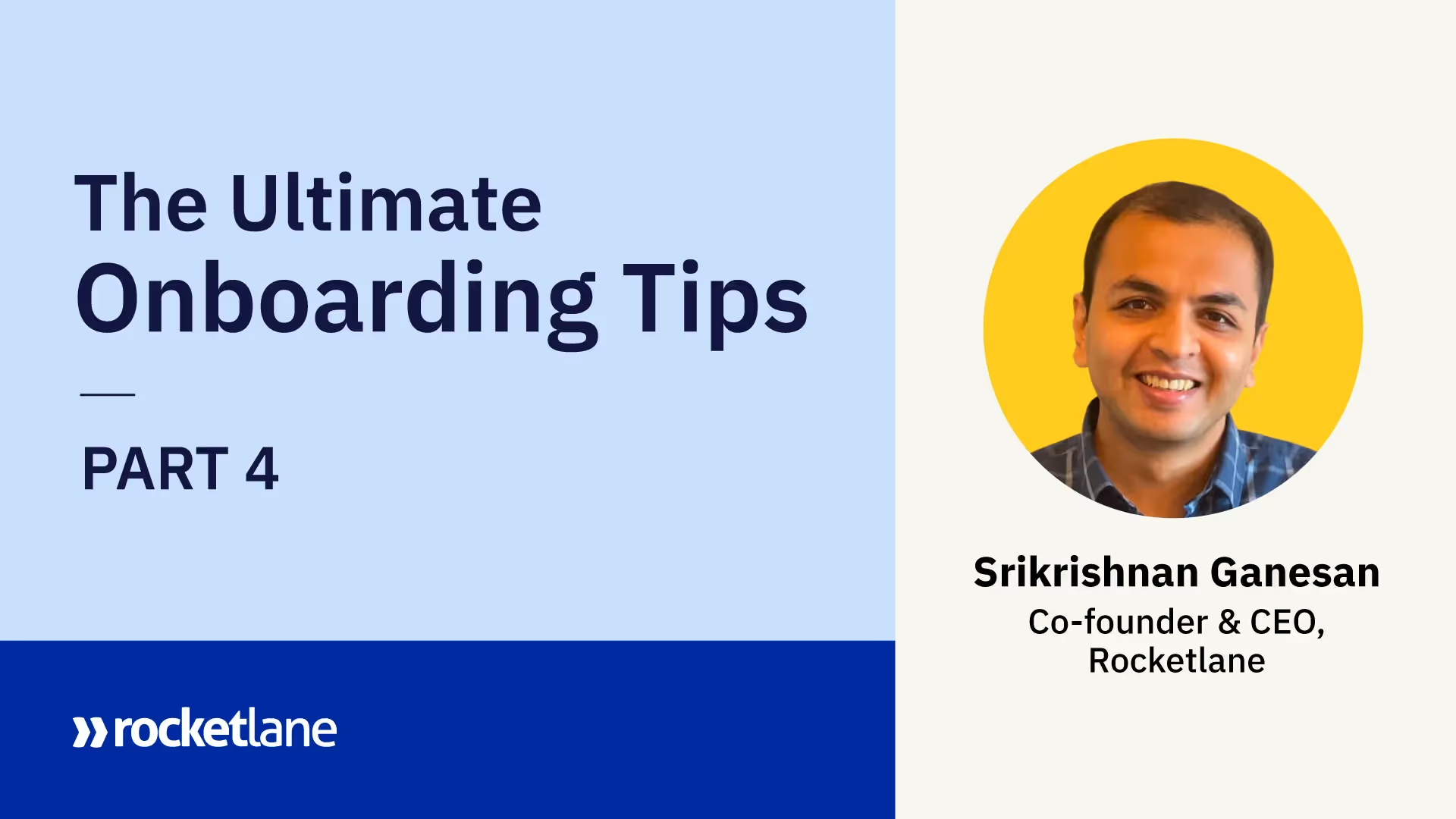Welcome to Part IV of the Customer Onboarding Tips blog. In part III, we looked at how you can celebrate an Onboarding Day, conduct an ROI workshop for every customer, and carve out specialized roles within your team for onboarding.
In this blog, we’ll look at the importance of continuous feedback, having the human touch in onboarding, setting a cadence for communication, and more.
Let’s jump right in.
Tip #16: Continuous feedback and milestone-based CSAT
When you ask your Onboarding Specialist how things are going with a critical account, they tell you everything is under control.
"It's on track."
But four days before the planned go-live, you get an escalation from the customer. They were promised that things would happen on time, but now they're told it would take three more weeks to complete the requested integrations. Your team kept assuring them all this while, only to have been told otherwise at the last minute. Does this sound familiar?
Here's another example. A customer pings you three weeks into the onboarding to share that they don't have confidence in your team's ability to execute on this implementation. They sort of have been unhappy ever since kickoff. The training thus far has also been sloppy, and they sense a lack of preparation.
So, how do you catch these tricky situations earlier? How do you ensure that your customers are always on the same page and aren’t caught off guard?
Through continuous feedback, of course!
Always poll the customer side execs and POCs for a CSAT at each key milestone in the journey. This way, you'll understand the customer's sentiment on an ongoing basis and can act fast and turn a situation around when you sense things are not going too well. Even before an escalation, you will get to know if the customer isn't too thrilled with how you are delivering.
Similarly, you can see patterns across projects and people on your team:
- Is a particular Customer Success Manager or Onboarding Specialist typically receiving lower ratings for their training or solutioning workshop?
- Is the company getting a consistent 3/5 for the kickoff meeting? Are you not impressing them at that early stage?
You can answer these questions and more by looking at your CSAT scores and analyzing them over time.
If you want to try this out, Rocketlane has a native CSAT capability so you can survey your customers on the delivery of each key milestone in the onboarding journey!
Tip #17: The human connect
Remember a time when you'd visit a large customer while onboarding them? The in-person kickoffs and go-lives, the coffee breaks and lunches with the customer, the walks through the corridor, all the things you learn and share about each other's day, personal and professional goals, and of course, the rapport you establish in the process?
In a world where we live from Zoom call to Zoom call, there's no way to replicate these informal moments.As a result, transactional relationships and missing trust/rapport between teams make it harder to partner well with your customers.
I was discussing this with Irene Lefton of MentorCloud recently. As someone who's worked with remote organizations for years, she shared how integral it is to build a good rapport with all the customers you're onboarding.
My mind immediately returned to a recent onboarding I had experienced with Gong. Our kickoff call had all the elements you'd expect: a recap and confirmation of our goals, a timeline/plan showcasing the activities in the journey, and a map of who does what.
But it also had an interesting slide.
A slide about , Marina, the Customer Success Manager (CSM) who was onboarding us. The slide that helped us learn a little more about Marina the person, beyond her role as CSM. Making this slide a part of the kickoff template is a forcing function for the two teams to take a moment and get to know each other before getting down to business.
Great idea, right? Try it out, and let us know how it goes.
P.S. We're planning to make a personalized Zoom background this week for each team member on our team along the same lines.
Tip #18: Set a cadence and protocol for communication
We covered the "License to chase" in Tip #15, which was about setting expectations on your follow-up style and escalation protocols during kickoff. This communication style ensures your team doesn't feel awkward about aggressively following up or communicating the actual status with a larger group through the implementation and onboarding project.
But even beyond follow-ups, having a clear communication protocol early on helps keeps things on track and creates a better experience for everyone involved. You come across as a professional team, which also helps keep everyone accountable and avoids issues arising from lack of visibility (such as people dropping the ball). Here are some essential areas your communication plan should cover:
- How often will you be publishing the status of the project?
- What gets highlighted in the status? What's the format?
- What is the communication that will go out to executive sponsors?
- How often will you have meetings? Who will be invited to them?
- Who will publish the meeting minutes, and where can anyone who wants to see the minutes access them?
- What modes will be used for async communication, and how soon can parties expect responses?
A slide in your kickoff deck that covers all of this establishes the rules and expectations for smooth team engagement. It also is a forcing function for your team to follow the communication process.
While there's no correct configuration for communication and meetings, it is still crucial to establish and get on the same page with respect to how you will run the customer onboarding.
We also have a detailed blog post on the topic!
Tip #19: Intensity
The real reason why customer onboardings usually get delayed is that everyone takes their foot off the pedal once the deal is done and the contract is signed.
The usual reason being, "It's in the bag anyway, we'll have a chance to change things or recover if there's some slippage or an escalation."
You move into a less intense motion when you should see the next phase through with equal or more intensity.
So how do you create the right intensity during onboarding?
1. If you have a long onboarding journey, you need to hire program/engagement managers with the right experience and hustle to push things through with that intensity as a companion to your onboarding consultant or implementation engineer.
2. Create rituals or forcing functions that ensure intensity.
- Have an intensity score your team needs to update against each account for your leaders to review/be aware of. The score is high if the task completions for the week are equal to or more tasks than planned.
- Stand-up meetings twice weekly with the whole project team if the execution is behind plan.
- Recognize team members who operate with high intensity. Give them titles like "Project Champion of The Week" for each week when someone makes substantial progress on what's on their plate.
Have other ideas to keep the intensity going? Do let us know!
Tip #20: Engineer teachable moments into your customer onboarding
Q: What makes customers want to work with you?
A: When they know you help them grow in their function/role/career.
This tip helps you push beyond merely implementation and training to introducing opportunities for "teachable moments" as part of your onboarding journey with customers.
By teachable moments, we mean opportunities that arise naturally where you can impart functionally useful learning to the customer in a contextual manner.
Here are some examples:
- Asking probing questions as part of kickoffs, workshops, or training sessions that help the customer reflect on how they do things today and how they can level up in their function
- Sharing best practices in the context of product training sessions that customers can easily see as beneficial to how they function
- Giving examples of how you use your product in your business as a way to help the customer understand how they can do their role like you, the expert in that domain
We're fortunate at Rocketlane because Onboarding is the very function we are selling into. So how we do our onboarding can, by itself, create some teachable moments! Starting this week, we aim to ensure we craft an onboarding journey where every new customer takes away 2-3 learnings (e.g., Reverse Demo) around customer onboarding just from experiencing how we do our onboarding!
So, do you do anything as part of your onboarding that creates learning for your customers? Drop us an email at care@rocketlane.com!
You might also like: How Rocketlane Does Onboarding: People, Process, Tools






















.webp)